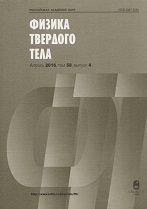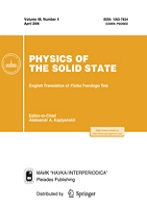|
This article is cited in 7 scientific papers (total in 7 papers)
Surface physics, thin films
Structural, optical, and thermoelectric properties of the ZnO : Al films synthesized by atomic layer deposition
I. A. Tambasova, M. N. Volochaeva, A. S. Voroninb, N. P. Evsevskayaac, A. N. Masyugind, A. S. Aleksandrovskiiae, T. E. Smolyarovabe, I. V. Nemtseva, S. A. Lyaschenkoa, G. N. Bondarenkoc, E. V. Tambasovad
a L. V. Kirensky Institute of Physics, Siberian Branch of the Russian Academy of Sciences, Krasnoyarsk, Russia
b Krasnoyarsk Scientific Center of SB RAS, Krasnoyarsk, Russia
c Institute of Chemistry and Chemical Technology, Krasnoyarsk Scientific Center, Siberian Branch, Russian Academy of Sciences, Krasnoyarsk, Russia
d M. F. Reshetnev Siberian State University of Science and Technologies
e Siberian Federal University, Krasnoyarsk
Abstract:
Aluminum-doped zinc oxide thin films have been grown by atomic layer deposition at a temperature of 200$^\circ$C. Using X-ray diffraction, it has been established that the ZnO:Al thin films exhibits the reflections from the (100), (002), (110), and (201) ZnO hexagonal phase planes. The (101) and (102) planes have also been detected by electron diffraction. The ZnO:Al thin films grow smooth with a root-mean-square roughness of $R_q$ = 0.33 nm and characteristic nanocrystallite sizes of $\sim$70 and $\sim$15 nm without additional aluminum or aluminum oxide phases. The transmission at a wavelength of 550 nm with regard to the substrate has been found to be 96%. The refractive indices and absorption coefficients of the ZnO:Al thin films in the wavelength range of 250–900 nm have been determined. The maximum refractive indices and absorption coefficients have been found to be 2.09 at a wavelength of 335 nm and 0.39 at a wavelength of 295 nm, respectively. The optical band gap is 3.56 eV. The resistivity, Seebeck coefficient, and power factor of the ZnO:Al thin films are $\sim$1.02 $\times$ 10$^{-3}$ $\Omega$ cm, –60 $\mu$V/K, and 340 $\mu$W m$^{-1}$ K$^{-2}$ at room temperature, respectively. The maximum power factor attains 620 $\mu$W m$^{-1}$ K$^{-2}$ at a temperature of 200$^\circ$C.
Keywords:
atomic layer deposition, thin films, aluminum doped zinc oxide, structural and optical properties, thermoelectric properties.
Received: 15.04.2019
Revised: 15.04.2019
Accepted: 17.04.2019
Citation:
I. A. Tambasov, M. N. Volochaev, A. S. Voronin, N. P. Evsevskaya, A. N. Masyugin, A. S. Aleksandrovskii, T. E. Smolyarova, I. V. Nemtsev, S. A. Lyaschenko, G. N. Bondarenko, E. V. Tambasova, “Structural, optical, and thermoelectric properties of the ZnO : Al films synthesized by atomic layer deposition”, Fizika Tverdogo Tela, 61:10 (2019), 1941–1947; Phys. Solid State, 61:10 (2019), 1904–1909
Linking options:
https://www.mathnet.ru/eng/ftt8680 https://www.mathnet.ru/eng/ftt/v61/i10/p1941
|


| Statistics & downloads: |
| Abstract page: | 54 | | Full-text PDF : | 24 |
|



 Contact us:
Contact us: Terms of Use
Terms of Use
 Registration to the website
Registration to the website Logotypes
Logotypes